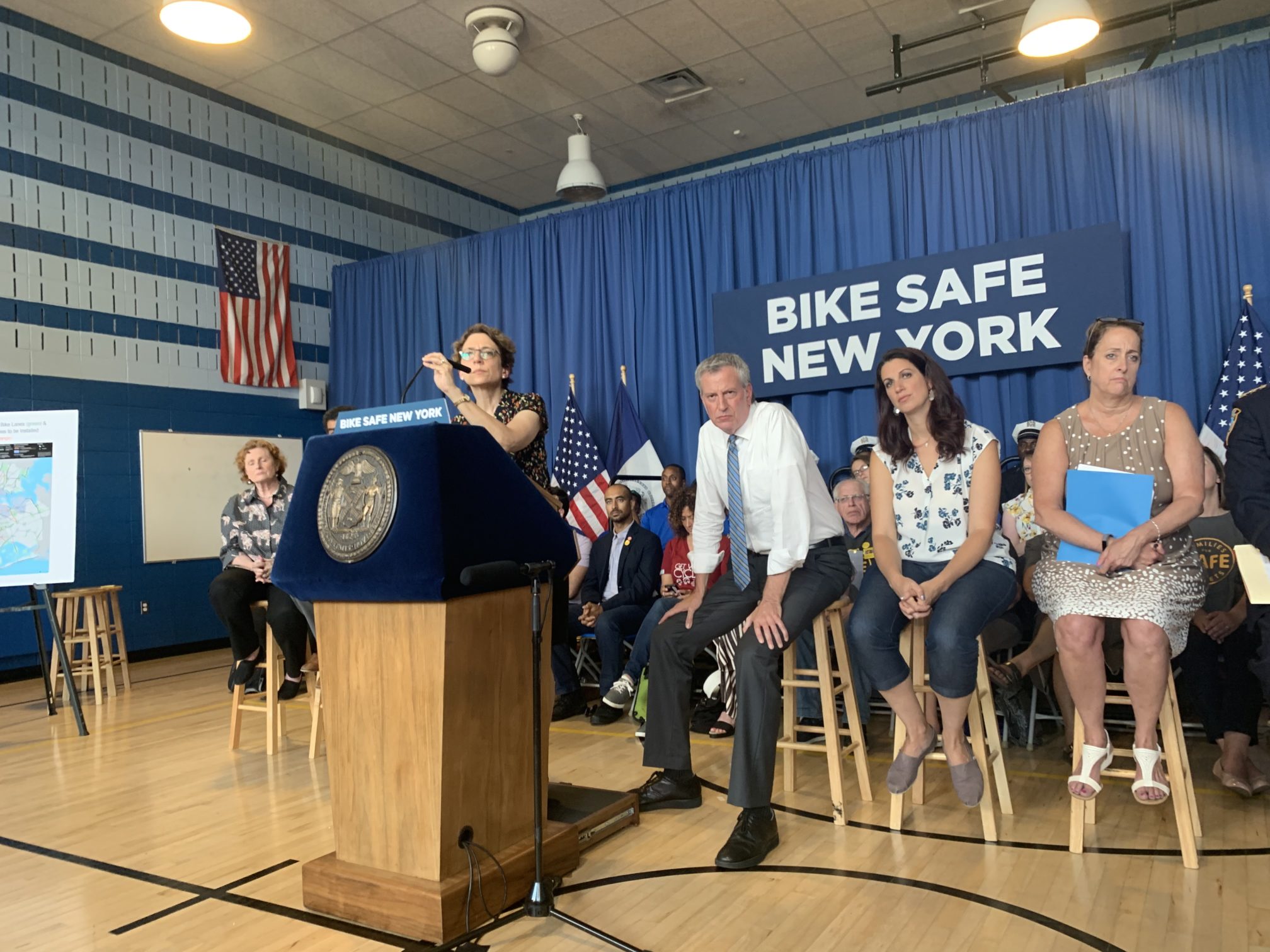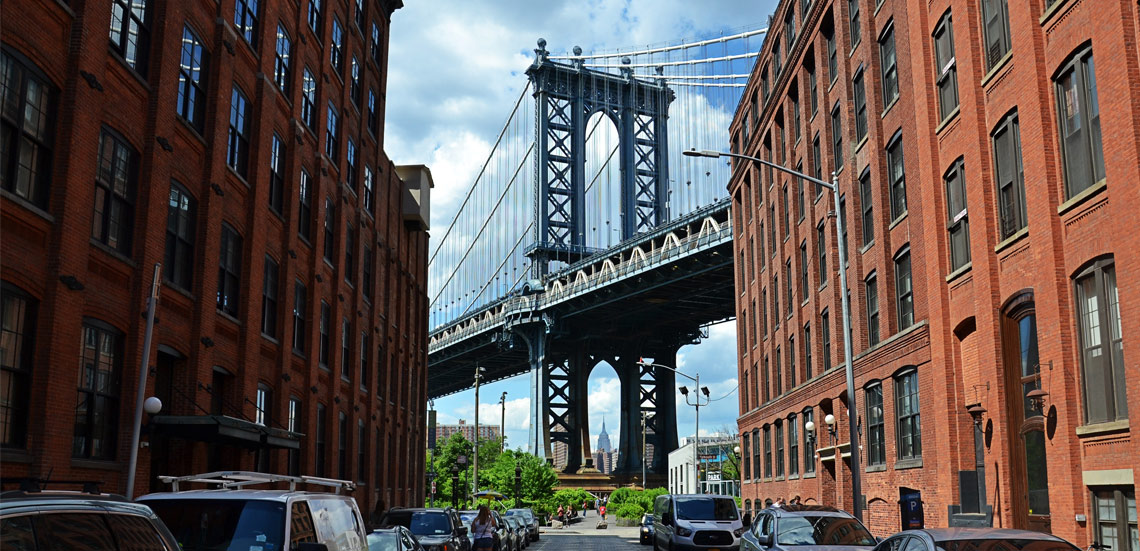
More bike lanes and fewer parking spaces, Mayor de Blasio announces

New York City will increase the pace of bike lane construction — particularly in southern Brooklyn neighborhoods — eliminate “thousands” of parking spaces and increase police enforcement following a spate of cyclist deaths throughout the city, Mayor Bill de Blasio and Department of Transportation Commissioner Polly Trottenberg announced in Bay Ridge on Thursday.
The mayor’s announcement comes as the total number of cyclists killed this year climbed to 17 this week, with two riders struck and killed Tuesday, including the 12th rider killed on the streets of Brooklyn. By comparison, only 10 riders were killed citywide in all of 2018.
“It’s a crisis. It’s an emergency. We can never look at such a moment like this and think we can do things the same way. We have to feel what all those families are going through right now,” de Blasio said, standing in front of a sign that said “Bike Safe New York.”
Alongside Trottenberg, the mayor unveiled his “Green Wave” plan as a component of his Vision Zero initiative, which seeks to bring cyclist, pedestrian and driver deaths down to zero by the year 2024.
The plan sets a goal of increasing the rate of construction of protected bike lanes to 30 miles per year, up from 20 miles per year at the current rate.
It focuses on “Priority Bicycle Districts,” which are defined as neighborhoods with high ridership but “lack adequate bicycle infrastructure.” Brownsville, Midwood, Sheepshead Bay and Bay Ridge are the priority districts in Brooklyn.

It remains unclear the role local community boards will play in the plan’s rollout. By law, the DOT has to go before such advisory boards with its proposals, though the agency doesn’t always move forward with their recommendations.
Still, pressure from community boards has been effective at slowing down DOT proposals, sending the agency back for revisions or convincing them to drop it altogether.
Trottenberg has previously said that community boards are “the biggest challenge to building out the bike network.” Similar skepticism has been raised about City Council Speaker Corey Johnson’s recently announced plan to “break the car culture” by prioritizing bike lanes.
Another cycling infrastructure advocate, Councilmember Antonio Reynoso, has proposed limiting the amount of back-and-forth between the DOT and community boards to speed up the process — but has not introduced any legislation to that effect.
Without committing to a change in policy, de Blasio said he valued the input of community boards but would prioritize safety.
The Green Wave plan pledges $58.4 million dollars over five years to implement “design, enforcement, legislation, policy and education” to make the city’s streets safer for cyclists, and would include the hiring of 80 new DOT workers.
“For the first time, we are committing this city to a truly citywide protected bike lane network. Eighty more miles by 2021, which will bring the total under this administration to 160 miles of protected bike lanes,” de Blasio said.
The enforcement aspect of de Blasio’s plan focuses on the “100 most crash-prone intersections,” with officers targeting drivers who speed, fail to yield and block bike lanes.
Trottenberg emphasized that the increase in deaths in 2019 was a Brooklyn phenomenon. She attributed the deaths to increases in ridership in previously industrial areas.
“The spike is really very heavy in Brooklyn. The numbers in the other boroughs are sort of tracking as they have in recent years,” the DOT commissioner said Thursday. “A lot of [the crashes] have involved trucks. We’re seeing them in some of these areas where cycling is increasing, and cycling is really growing all over the city, it’s growing in Brooklyn. Areas where perhaps they were previously industrial. There’s a lot of commercial activity. Cyclists and trucks are mixing in the streets.”
Brooklyn Borough President Eric Adams supports the mayor’s plan.
“It is long past time we get serious about building out a truly connected network of safe bike infrastructure, including a focus on priority corridors in under-served communities like Bay Ridge, Brownsville, Midwood and Sheepshead Bay,” Adams said.
Councilmember Ydanis Rodriguez — who chairs the City Council’s Transportation Committee — lauded the plan, but called on the mayor to go a step further and commit to installing 100 miles of protected bike lanes per year. The mayor responded that there’s a natural tension between him and the legislators, and that he’s trying to get to a realistic goal.
Even some safe streets advocates cautiously commended the mayor’s new plan.
“We’re pleased to see Mayor de Blasio doubling down on his mandate to save lives and empowering the DOT to bring sweeping changes to our streets. We won’t be discouraged by the recent increase in bicyclist deaths; it’s clear that the mayor won’t either,” said Marco Conner, deputy director of Transportation Alternatives.
According to a press release, de Blasio’s plan includes the following elements:
Create a citywide protected bike lane vision:
- To implement the Green Wave plan, the city has committed $58.4 million in new funding over the next five years, with 80 additional new staff.
- Build 30 miles of protected bicycle lane annually, guided by a PBL vision document. By the end of 2021, DOT will install over 80 miles of protected lanes. These projects are currently in various stages of planning and design.
- DOT has identified 10 Brooklyn and Queens community boards as Bike Priority Districts, which together represent 16% percent of community boards and 14 percent of the bike lane network — yet have 23 percent of all NYC’s bicycle fatalities. DOT has committed to build 75 miles of bicycle infrastructure in these districts by 2022.
- Spur increase in cycling mode share for safety and emissions reduction, furthering OneNYC 2050 goal that 1 out of every 10 trips in NYC be taken by bicycle.
Improve and update design:
- DOT will build upon innovative intersection designs with a focus on areas where the majority of fatalities occur.
- Fifty intersections will receive turn calming treatments in 2019 and where possible, protected intersection designs will be added for new projects after streets are resurfaced or reconstructed.
- Among innovations, DOT will in 2019 pilot so-called “Green Wave,” progressive signal-timing that discourages speeding and encourages steady cycling speeds — and it will identify other corridors for implementation in 2020.
- Install Green Skip Bars at key intersections to increase cyclist visibility.
Expand NYPD enforcement:
- Under the plan, the NYPD will ramp up enforcement at the 100 most crash-prone intersections and target enforcement on highest risk activities: speeding, failing to yield, blocking bike lanes, oversized trucks/trucks off route.
- Maintain continuous citywide implementation of “Operation Bicycle Safe Passage” initiative — extending elevated enforcement of blocked bike lanes and hazardous driving violations. Since implementation of Operation Bicycle Safe Passage, NYPD has doubled enforcement of cars parked in bicycle lanes and issued more than 8,600 summons in the first three weeks of July.
- Specialized units and precincts will increase enforcement against oversized and off-route trucks.
- The NYPD also announced that supervisors would respond to collision sites to determine if the right-of-way laws should be applied — and that it would also discontinue its practice of ticketing cyclists at the site of fatal cyclist crashes.
- NYPD supports new and emerging technology for automated enforcement.
Promote legislation and implement policy
- DOT will both make new rules and work with the City Council and State Legislature in support of legislation increasing safety for cyclists and all road users. The agency will partner with various local and state agencies to advance cyclist safety.
- Among the specifics, DOT will implement local legislation that passed the council this week that allows cyclists to proceed on the pedestrians signal and will work with the Speaker and Council Members to pass additional legislation requiring a three-foot passing distance between car and cyclist and enhanced requirements for trucks sideguards.
- DOT will also explore and evaluate the capabilities of existing and emerging technology for automated enforcement technologies to keep bike lanes clear, as well as enforce overweight truck restrictions, and determine the feasibility of obtaining state legislative approval for use of these technologies.
- DOT will institute new requirements to protect cyclists around work zones, under legislation recently passed by the council, and increase maintenance and markings inspection capacity.
- DOT will install 2,000 bike parking spaces annually through bike corrals and issue an RFEI to evaluate the possibility of a new high-capacity bicycle parking system.
Target trucks in major safety initiative
- DOT will work with its partners in the trucking industry to address fatalities involving trucks, which have constituted over 50% of recent cyclist fatalities.
- DOT will convene a Vision Zero Truck Safety Task Force.
- DOT will develop instructional videos and materials for large fleets, private sanitation companies and freight industry partners. DOT will also expand the “Trucks Eye View” educational program.
- DOT will implement loading zones in residential areas and evaluate curb management in commercial areas, with the expansion of the Off-Hour Deliveries program.
- DOT will also pursue an expedited timeline for installation of side guards for all Business Integrity Commission-licensed and registered private garbage-collection vehicles.
Continued expansion of outreach/helmet safety
- DOT will continue its use of successful media campaign to promote safety, including a focus on the “Get There” bike encouragement and safety campaign messaging through weekly events and education programming.
- DOT will expand a companion education portion to the defensive driving and training programs at local driving schools as well as expand the citywide 7th Grade Bike Safety Program in collaboration with DOE and Bike New York.
- DOT will also work with Citi Bike to provide free helmets to NYCHA residents who become Citi Bike members.
Leave a Comment
Leave a Comment






there are now more bikers… so there will be more accidents. trucks are causing the accidents so why are we penalizing car owners in the areas where the accidents are occurring by removing parking spots.. frustration of not finding parking where you live, in a hurry to get somewhere , not paying attention.. are some of the causes of accidents.. how many bikers hit pedestrians… should we get rid of pedestrians. bikers need to be educated how to ride in traffic and around people… stop signs and red lights apply to all , especially bikers . drivers need to be educated how to drive around bikers… getting rid of thousands of parking spots will add to more accidents as the frustration of not finding a parking spot will increase… as will the time needed to find a parking spot .. the pollution will also increase.
educating bikers and drivers will help.
These people could pay to park their cars in a garage or a lot. Free on-street parking is not a god given right. Or they could always just get rid of the and make sure without one like the vast majority of this city does.
Those thousands of parking spaces lost will increase the safety and enhance the commute of tens of thousands of bike commuters.
at one time it was that easy… no longer.
its possible that most of these accidents are caused by vehicles going to somewhere and not local residents..why penalize the people living in that area.
also…. riding a bicycle is not an alternative for everyone.
over the last many years new big and medium residential developments have been built in every neighborhood around the 5 boros .. some have been built on parking lots and garages…many of these developments have minimum to zero parking. street parking has dwindled and will continue to dwindle. less available street parking and parking lot alternatives has locals looking for a spot sometimes for hours… causing pollution, frustration and possible accidents…
many of these new condo residential bldgs also replaced warehouses where people worked. displacing those workers. many businesses have moved to longisland jersey etc… where there had been 5 cars for a business , now with these multi family residential buildings , now there are 50 cars added to the area looking for parking,
some people have lived in these areas for decades and now they cannot park in the area and there is no garage or parking lot alternative.
these residential developments have added 10′ s of thousands if not hundreds of thousands of people to the transit system..
one thing effects another… many workers displaced from local jobs now travel further away to work . over crowded mass transit , and 4 hour commute times are not alternatives for most. a car is needed.. and bikes are not an alternative.
driver and biker education will help everyone..
bikers also hit pedestrians. 531 bikers hit pedestrians in 2017.
pedestrians walking aren’t paying attention. we all need to pay attention when we are walking driving biking.. traffic signals are for all..
when i drive.. and the light turns green… i go slowly in case a bike comes flying through the crosswalk, a walker decides to walk when the signal is red, or a car tries to beat the light.
getting rid of thousands of parking spots is not the answer.
The answer is to demand better public transportation for your area if biking is not an option for you then. Not more cars in an already way over congested city. This city needs less cars.
Do you really want to quote statistics about bicyclists hitting pedestrians? Because there were 10,561 pedestrians on foot hit by cars in 2017 and about 4,397 bicyclists hit by cars in 2017. Together almost 15,000 pedestrians that were hit by cars in 2017. It’s, frankly, ridiculous you’d even quote that figure when you look at the figures for cars. You also jumbled your numbers. It was 315 pedestrians on foot hit by bicyclists, not 531.
The bottom line is bike lanes serve exponentially more city residents than on-street vehicle storage. It’s a no brainer to utilize that resource for the larger group.
Without cycling laws revised and implemented to the fullest extent of the law, nothing will change. Defensive cycling and yielding to pedestrians is the most important law for all.